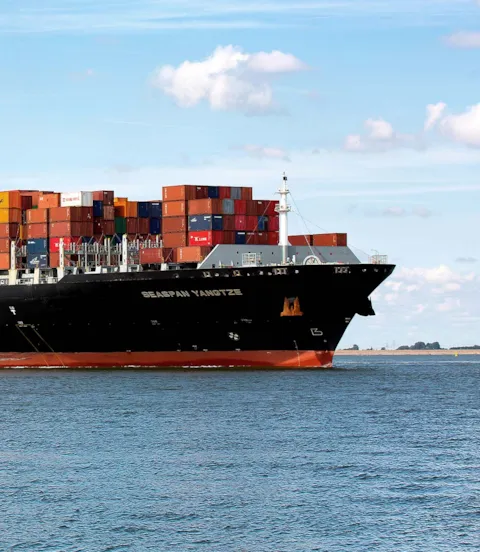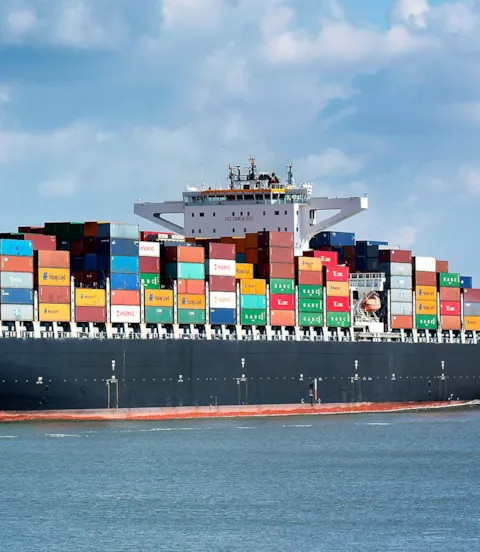Building on two decades of partnership for an efficient and decarbonized future
With an instinct for innovations and a customer-centric approach, Seaspan Corporation aims to realize its ambitious growth strategy. But handling all the complexities of rapid growth and new legislation needs a collaborative approach to succeed. DNV supported the containership owner right from the start.
Celebrating its 20th anniversary as a shipping company, Seaspan Corporation has overcome all the hurdles the industry has faced over the last two decades. Today the company’s ever-growing fleet comprises roughly 200 vessels including newbuilds, ranging from 2,500 TEU to 24,000 TEU. Most Seaspan ships are DNV-classified, a result of 20 years of close cooperation between the organizations and a shared innovative spirit. Seaspan’s ambitious ongoing newbuilding programme focuses on eco-friendly solutions, including a large share of LNG-fuelled, and some even bring ammonia-ready ships, as the next step on the path towards a decarbonized future.

A legacy of innovative thinking
When the maritime industry went into “scorched earth territory” after the financial crisis, as Chief Commercial Officer Peter Curtis puts it, Seaspan was looking for a longer-term perspective and found it in designing more efficient, eco-friendly ships. Chief Operating Officer Torsten Holst Pedersen explains: “As one of the biggest owners of containerships we would like to be part of setting the decarbonization agenda.” Curtis adds: “DNV’s low-carbon containership design concept ‘Quantum’ provided a vision.” Key features of Quantum included dual-fuel engines, waste heat recovery, exhaust gas recirculation, an optimized hull design, and a low ballast water requirement.
“We took all these great ideas from that design concept home with us and developed our own SAVER design – Seaspan Action on Vessel Energy Reduction,” says Curtis. “As soon as the market started moving again, we ordered twenty-five 10,000 TEU SAVER ships, one of the biggest series ever. That was all a result of our work with DNV.”

Efficient and eco-friendly containership design
The focus was not on fuel efficiency alone, stresses Curtis. Another aspect of operational efficiency was how many loaded TEUs can be transported on one tonne of fuel at a specific speed. Calculations showed that the new 10,000 TEU vessels were about 20 per cent more efficient than the previous 9,600 TEU generation, a surprising accomplishment, says Curtis. “So we were the first ones out the gate with true eco-containerships.”
Seaspan followed up with fifteen 14,000 TEU newbuilds based on the SAVER concept. “And now we are building 15,000 TEU ships with LNG propulsion,” Curtis adds.

Technology Advisory Council delivers key insights
“There are many regulatory changes coming, such as the IMO ambitions,” says Curtis. “We do not want to repeat the nightmare of the ballast water treatment story. We want to avoid different regimes springing up.” Since Seaspan cannot hire all the required experts, Curtis decided to collaborate with those who have the expertise. “I set up a Technology Advisory Council (TAC) where we meet once every quarter to discuss current developments.” The TAC includes a representative from the downstream oil and gas industry, from the ship engine manufacturing sector, and from DNV. The regular meetings help to provide clarity about what has worked well, what has failed, and what has good potential, says Curtis. Summaries of meetings are then discussed internally at Seaspan.
The TAC is not the only platform where Seaspan seeks inspiration through collaboration. The company joined the Mærsk Mc-Kinney Møller Center for Zero Carbon Shipping earlier this year. “Some problems are simply too big and too important to be handling them alone,” says Pedersen. “This is real climate action and one way we can take a leadership position, together with other industry stakeholders, to accelerate the development and implementation of new energy systems and technologies.”

On the road to decarbonization
“The younger generations are very serious about saying ‘You are not going to cook this world for us’,” says Curtis. “We need to start changing our behaviour. At Seaspan we are well on the road with our own ESG [environmental, social and corporate governance] principles, and DNV supports us there.”
Pedersen agrees: “We have to do it the right way instead of digging ourselves into the trenches and yelling at each other. The question is: what do we build now?”
While there remains complexity around decision-making for fuels of the future, Seaspan has made up its mind how to reduce its carbon footprint today – the answer is LNG. “This is one example of how the collaboration with DNV in our TAC helps us,” comments Pedersen. “LNG benefits the environment, there is a good business case for it, and we believe we can run these vessels until the end of their lifetime and still comply with increasingly stringent regulations, for example by introducing the use of biofuels to the mix. And we will learn a lot for the next types of alternative fuels that will come up.”
We need to start changing our behaviour. At Seaspan we are well on the road with our own ESG [environmental, social and corporate governance] principles, and DNV supports us there.

Managing growth through digitalization
Growth brings complexity. Keeping business processes simple is becoming a major challenge, says Pedersen. “It is a bit like building the aeroplane while you fly. But growth should not make us less agile or less customer-centric. Therefore, we focus on simplicity and scalability through digital transformation.” Automating and digitalizing business processes provides the team at Seaspan more time to evaluate and develop new and innovative solutions, he adds.
Implementing an advanced Ship Energy Efficiency Management Plan (SEEMP) solution ten years ago was a first successful digitalization move, recalls Curtis. “I didn’t want captains to have to sit down and write things out by hand, so we brought in DNV and ended up with this really futuristic SEEMP solution. That kind of culture has grown in Seaspan.” Pedersen adds: “DNV’s own digitalization journey serves as a blueprint for what we want Seaspan to do.”
I didn’t want captains to have to sit down and write things out by hand, so we brought in DNV and ended up with this really futuristic SEEMP solution. That kind of culture has grown in Seaspan.

Focus on the customer
“Just like ourselves, DNV has a focus on improving the business of its customers,” Pedersen points out. “The partnership between DNV and Seaspan has become stronger over the years because DNV has helped make our business successful and come up with ideas that benefit the solutions we provide to our customers. We also enjoy discussing strategic issues with DNV. When I hear our people say: ‘Just call DNV to discuss this’ as the first response when an issue comes up, then DNV has done something well.” Curtis puts it this way: “It’s the culture. DNV practises it. It’s not an ethereal thing. It is practice.”

Operational excellence builds reputation
In recent years Seaspan has pursued an ambitious growth strategy. “Scale is a big success driver in container shipping. Building a large fleet helps us drive economies of scale, drive down costs, and gives us the size and resources to take on a leadership role,” explains Pedersen. And Curtis adds: “If you play it right, 20 years bring a reputation you can rely on.” Curtis, who has been with the company from the beginning, is responsible for the commercial management of Seaspan’s owned and managed vessels. He sees Seaspan’s fleet of young, high-value ships and the long-standing partnership with DNV as competitive advantages.

Two decades of collaboration with DNV
Curtis and Pedersen agree that the shared innovative spirit and Seaspan’s trust in DNV’s classification and advisory services form the foundation of the two-decade relationship between the organizations. From any location around the globe, the ability to access the same consistent support and to draw on the comprehensive knowledge of DNV adds strong value to the partnership, says Pedersen. “They may not always have all the answers, but they will probably learn of an answer before we do because of their exposure to many different industries and players.” Curtis adds: “DNV is there to help us navigate the increasing complexities of the industry, so we can avoid taking steps that would be difficult to recover from.”
- Seaspan
- Seaspan

